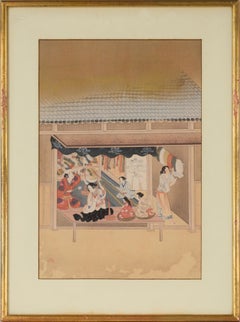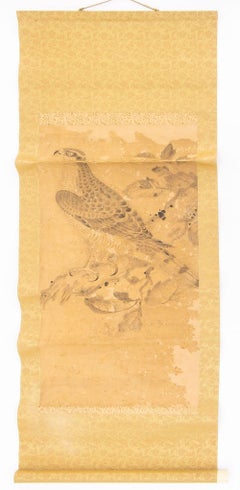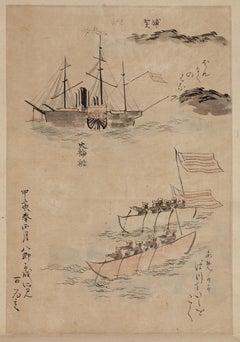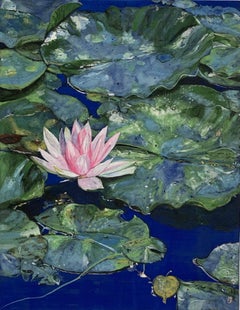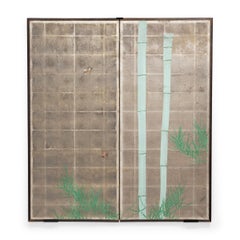Edo Paintings
to
1
1
1
3
Overall Width
to
Overall Height
to
3
2
2
43,162
37,889
22,491
8,473
4,039
3,625
3,341
2,431
1,229
1,217
1,097
1,022
429
295
4
1
2
2
2
1
1
1
1
1
1
1
1
1
1
1
1
5
5
1
1
1
1
1
1
3
2
Style: Edo
Authentic Japanese Woodblock Print-White Cat-Hanabusa Itchō-Edo-Re-carved 1920s
Located in London, GB
This rare Original 1920s authentic print is a Taisho Period Woodblock print published from the Japan 1920's The Nippon Mokuhan Gasui, Masterpieces Series.;
it is authentically hand ...
Category
1920s Edo Paintings
Materials
Ink, Handmade Paper
Japanese Artisans - Silk Dying -Japanese Woodblock Print
By Tosa Mitsuyoshi
Located in Soquel, CA
Japanese Artisans - Japanese Woodblock Print J
Japanese woodblock depicting six women, all wearing vibrant kimonos, working on crafts by Tosa Mitsuoki (Japanese, 1617-1691). Japanese,c. 1600. Handcraft depiction (dye works).Section from a painted screen with presentations of handcraft.Kita-in, Saitama.
Stamped lower left.
Presented in a white mat and giltwood frame.
Frame: 19"H x 14"W
Mat: 18.25"H x 13.25"W
Image: 14.5"H x 9.5"W
Tosa Mitsuoki was a Japanese painter, reinvigorating the Yamato style of classical Japanese painting. Yamato-e originated from interest in reproducing early Tang dynasty paintings, and was later reinvented and further refined to fit Japanese cultural perceptions in the late Heian period. Yamato, sometimes referred to as wa or kazu had become synonymous with the Tosa-ha by the Muromachi period as a way for Japanese artist to distinguish their works from those of mainland Chinese paintings, kara-e. Yamato-e incorporated various visual and literary techniques for establishing narrative. Works were not always accompanied with text and may rely on heavily on period specific visual motifs, icons, and symbols to relay a story or theme. Tosa style by the time of Mitsuoki focused heavily on depicting themes of plants and nature, famous places, meisho, the four seasons, shik, bird-and-flower, kacho. Many of these popular symbols and icons from mimicking Chinese practices, treating the original Chinese masterwork as a sort of prototype to improve upon. Popular formats for Mitsuoki's pictures were wall scrolls kakemono, or handscrolls that would be read from right to left with the accompanied story, sliding doors fusuma and folding screen panels byobu that featured up to six panels. Mitsuoki's style incorporated the depth and calligraphy techniques of ink wash brushwork similar to Song dynasty and Yuan dynasty Chinese court paintings...
Category
1920s Edo Paintings
Materials
Paper, Ink, Woodcut
Japanese School Perched Hawk Scroll Painting
Located in Astoria, NY
Japanese School, Landscape Scene of a Perched Hawk, Ink on Paper, 19th century, mounted on a silk scroll, remnants of chop seal mark lower right, together with wooden box with callig...
Category
19th Century Edo Paintings
Materials
Silk, Paper, Ink
Japanese Festival Folding Screen, Paint on Paper
Located in Chicago, IL
This folding screen is a stunning example of Japanese artistry. Beautifully painted with delicate brushwork, the evocative screen depicts a lively festival during the Edo period (1615–1912). The raucous scene is full of life; within the dense crowd, you can make out people dancing...
Category
19th Century Edo Paintings
Materials
Paper, Ink, Pigment
Scroll painting of the American ship commanded by Commodore Matthew Perry
Located in Amsterdam, NL
Attributed to Ukita Ikkei (1795-1859)
Hanging scroll painting of the American ship commanded by Commodore Matthew Perry in Uraga Bay, annotate...
Category
Mid-19th Century Edo Paintings
Materials
Paper, Ink
Related Items
Summer – Lotus by Lumi Mizutani - Japanese landscape painting, nature, flower
Located in Paris, FR
Summer – Lotus is a unique painting by contemporary artist Lumi Mizutani. The painting is made with japanese pigments, silver and gold leaves on Japanese paper mounted on panel, dime...
Category
2010s Edo Paintings
Materials
Silver, Gold Leaf
$2,988
H 16.11 in W 12.52 in
"Fanti Fishing Boat" Modern Abstract Figurative Woodcut Print 47 of 86
Located in Houston, TX
Abstract figurative woodblock print of a beach landscape with a boat. The print is stamped by the artist and titled and editioned in pencil. This print is editioned 47 of 86 and the print is not currently framed.
Artist Biography: Born in Gastonia, North Carolina in 1924, John Biggers studied at Hampton Institute (now Hampton University) under Viktor Lowenfeld and muralist Charles White. In 1943, Biggers' mural, Dying Soldier, was included in the exhibition curated by Lowenfeld, Young Negro Art, at the Museum of Modern Art in New York.
After serving in the United States Navy, Biggers transferred to Pennsylvania State University where he earned his bachelor’s and master’s degrees as well as his doctorate in art education. In 1949, Biggers accepted a faculty position at Texas State University for Negroes (now Texas Southern University) in Houston, where he founded and chaired the art department until his retirement. In the early 50s, he won prizes for his work at annual exhibitions held at the Museum of Fine Arts, Houston and the Dallas Museum of Art.
In 1957, he traveled to Africa on a UNESCO fellowship to study Western African cultural traditions, becoming one of the first black artists to study the culture first-hand rather than through library research. His work was profoundly influenced by his experiences in Africa.
He was known for his murals, but also for his drawings, paintings, and lithographs, and was honored by a major traveling retrospective exhibition from 1995 to 1997. He created archetypal imagery that spoke positively to the rich and varied ethnic heritage of African Americans, long before the Civil Rights era drew...
Category
Late 20th Century Edo Paintings
Materials
Woodcut
$1,500
H 14.75 in W 19 in D 0.04 in
1930s French Impressionist Watercolour of Children in an Idyllic Country Scene
Located in Cotignac, FR
French Impressionist watercolour on paper view of children in an idyllic country scene by Henri Clamen. Signed bottom right. Acquired from the atelier of the artist with other signed works. Pencil annotation top right and to the back of the paper.
A charming view of two children waiting in the shade of a beautiful summers day by the side of a country lane. An archway through to a farmyard and a farmhouse beyond. Dappled light through the overhead leaves and branches. In the lane to the left a hay wain...
Category
Early 20th Century Edo Paintings
Materials
Ink, Paper, Watercolor
$332 Sale Price
36% Off
H 9.06 in W 5.52 in
Hand painted Artist Proof-Magnolias-Weaver Series-British Awarded Artist #2 of 3
Located in London, GB
This stunning Artist's Proof is an one-off, oil hand-painted and gilded by the artist , signed at front and on the back label too; each proof is 80% hand painted and gold gilded by S...
Category
2010s Edo Paintings
Materials
Gold Leaf
$515
H 47.25 in W 31.5 in D 0.04 in
"Enshoku Sanju-roku Kasen" (Thirty-six Enchanting Flowers) Woodblock on paper
Located in Soquel, CA
"Enshoku Sanju-roku Kasen" (Thirty-six Enchanting Flowers) Woodblock on paper
Elegant woodblock print by Toyohara Kunuchika (Japanese, 1835-1900). Three women are in talking with each other inside, while a man waits outside holding a bag of some kind. The colors in this piece are rich and saturated, primarily blues, greens, and purple.
Mat size: 16"H x 20"W
Paper size: 14.75"H x 9.88"W
Born in 1835, Toyohara Kunichika grew up in the Kyobashi district of Edo in the midst of merchants and artisans. In 1848, at age 13, he was accepted as an apprentice into the studio of Utagawa Kunisada I...
Category
1880s Edo Paintings
Materials
Ink, Rice Paper, Woodcut
$475
H 20 in W 16 in D 0.25 in
Goldilocks - Green Goblin - Gyotaku Style Sumi Ink Painting of an Octopus
By Jeff Conroy
Located in Chicago, IL
A small octopus is inked in the Japanese style of Gyo-Taku print making. Using sumi ink to "print" the octopus, the artist then embellishes it with colored pencil to convey an extraordinary dimensionality. By printing it on hand-made Mulberry paper the artist achieves a beautiful aesthetic. This artwork is unframed. Contact gallery for framing options.
Jeff Conroy
Goldilocks - Green Goblin...
Category
21st Century and Contemporary Edo Paintings
Materials
Sumi Ink, Watercolor, Mulberry Paper, Color Pencil
Lemon Meringue - Gyotaku Style Sumi Ink Painting of a Multi-Colored Octopus
By Jeff Conroy
Located in Chicago, IL
A small octopus is inked in the Japanese style of Gyo-Taku print making. Using sumi ink to "print" the octopus, the artist then embellishes it with colored pencil to convey an extraordinary dimensionality. By printing it on Mulberry paper, which mimics the swirl of water, the artist achieves a beautiful aesthetic. The artwork is matted and framed in a simple white wooden frame measuring 18.25h x 24.25w x 1d inches.
Jeff Conroy
Lemon Meringue
sumi ink and colored pencil on mulberry paper
12.50h x 18.25w in
31.75h x 46.35w cm
JEC118
Gyotaku - A Japanese word translated from "gyo" meaning fish and "taku" meaning stone impression and is believed to get its inspiration from Chinese stone rubbings...
Category
21st Century and Contemporary Edo Paintings
Materials
Watercolor, Mulberry Paper, Color Pencil, Sumi Ink
$975
H 12.5 in W 18.25 in
Illustration Style Painting of Turkey Tail Mushrooms, Autumn Forest Landscape
Located in Barcelona, ES
"Turkey Tail Mushrooms" is an abstract expressionist painting by Romina Milano where a dance of black gestures unfolds across colorful brushstrokes infused with raw emotion.
Romina...
Category
2010s Edo Paintings
Materials
India Ink, Acrylic, Handmade Paper
Blue Pacific Foamy Shorelines, Horizontal Calm Seascape, Minimal Waterscape
By Kind of Cyan
Located in Barcelona, ES
This is an exclusive handprinted limited edition cyanotype.
"Pacific Foamy Shoreline" is a handmade cyanotype print portraying a smooth wave reaching the shore.
Details:
+ Title: Pa...
Category
2010s Edo Paintings
Materials
Watercolor, Lithograph, Paper
Waves of Clouds, Deep Blue Cyanotype Print, Pleasant Cloudy Sky, Large Triptych
By Kind of Cyan
Located in Barcelona, ES
This series of cyanotype triptychs showcases the beauty of nature scenes, including stunning beaches and oceans, as well as the intricate textures of water, forests, and skies. These triptychs are large pieces that feature lush blues, making them an impressive addition to any beautifully designed space.
Each triptych is printed by hand and carefully crafted to capture the unique essence of these natural environments, with a focus on the interplay of light and shadows, and the subtle nuances of tone and texture.
The beach and ocean scenes depict the dynamic beauty of waves crashing against the shore, with the cyanotype process lending a dreamy, ethereal quality to the images. Similarly, the forest and wood scenes...
Category
2010s Edo Paintings
Materials
Lithograph, Rag Paper
$704 Sale Price
20% Off
H 40 in W 83 in
Blue Tones Triptych, Serene Gorgeous Clouds, Handmade Cyanotype Watercolor Paper
By Kind of Cyan
Located in Barcelona, ES
This series of cyanotype triptychs showcases the beauty of nature scenes, including stunning beaches and oceans, as well as the intricate textures of w...
Category
2010s Edo Paintings
Materials
Emulsion, Lithograph, Monotype, Handmade Paper
Forest Triptych, Looking Up Through The Trees, Blue Nature, Handmade Cyanotype
By Kind of Cyan
Located in Barcelona, ES
This series of cyanotype triptychs showcases the beauty of nature scenes, including stunning beaches and oceans, as well as the intricate textures of w...
Category
2010s Edo Paintings
Materials
Lithograph, Rag Paper
Previously Available Items
Japanese Hanging Scroll of the Goddess of Mercy, c. 1800
Located in Chicago, IL
This exquisite hanging scroll painting from the late 18th century depicts the sacred form of the bodhisattva Guanyin, known in Japanese Buddhism as Shō Kannon, or Guze Kannon. Described as the "Buddha of Infinite Compassion" or the “Goddess of Mercy,” Kannon is the embodiment of empathy and grace and makes herself available to all who call upon her with all their mind. Typically depicted as a woman in Chinese and Japanese art, Kannon can take many forms and is often invoked to encourage fertility or alleviate suffering.
This painted scroll depicts the goddess Kannon standing upon a swirling cloud with lotus flowers beneath her feet. Backed by a moon-like halo, she exudes calm and elegance, dressed in flowing robes and intricate jewelry as she gazes downwards at the viewer. Her right hand is held towards the ground in vitarka mudra, a gesture of wisdom and teaching. In her left hand she holds a lotus flower which in turn supports the book of knowledge...
Category
Late 18th Century Edo Paintings
Materials
Copper
Japanese Silver Leaf Byobu Screen with Bamboo and Finches, c. 1800
Located in Chicago, IL
Paper folding screens known as byobu, or "wind walls," were used in Japanese homes to block drafts and partition interiors. Typically quite larg...
Category
Early 19th Century Edo Paintings
Materials
Silver
Japanese Geisha or Miko in Kimono with Fan Painting on Silk
Located in Houston, TX
Beautiful portrait of a Japanese woman dressed in a white shirt and bright red pants (hakama). She is dressed as a miko, or shrine maiden, a type of priest who works at a Japanese Shinto shrine...
Category
20th Century Edo Paintings
Materials
Silk
Edo paintings for sale on 1stDibs.
Find a wide variety of authentic Edo paintings available for sale on 1stDibs. Works in this style were very popular during the 19th Century, but contemporary artists have continued to produce works inspired by this movement. Frequently made by artists working with Ink, and Paper and other materials, all of these pieces for sale are unique and have attracted attention over the years. Not every interior allows for large Edo paintings, so small editions measuring 11.42 inches across are also available. Prices for paintings made by famous or emerging artists can differ depending on medium, time period and other attributes. On 1stDibs, the price for these items starts at $16,800 and tops out at $16,800, while the average work sells for $16,800.
Recently Viewed
View AllMore Ways To Browse
George Bruestle
George Tjungurrayi
Godwin Bennett
Goodnight Moon
Gudrun Sibbons Oil Paintings
Gudrun Sibbons
Guy C Wiggins
Hunt Slonem Violet
Jan Coutts
Joe Rader Roberts
John Foulger
John Pierce Barnes
Josep Roca Sastre
Landcaping Oil Paintings
Lovell Birge Harrison
Lucien Dhurmer Levy
Maurice Codner
Mexican Impressionism
